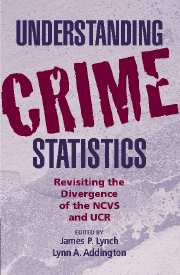Book contents
- Frontmatter
- Contents
- Acknowledgments
- Contributor Biographies
- INTRODUCTION
- OVERVIEW OF THE TWO NATIONAL MEASURES OF U.S. CRIME
- DEFINING DIVERGENCE AND CONVERGENCE
- SOURCES OF DIVERGENCE IN THE NCVS
- 5 Methodological Change in the NCVS and the Effect on Convergence
- 6 Series Victimizations and Divergence
- 7 Exploring Differences in Estimates of Visits to Emergency Rooms for Injuries from Assaults Using the NCVS and NHAMCS
- SOURCES OF DIVERGENCE IN THE UCR
- CONCLUSION
- Index
- CAMBRIDGE STUDIES IN CRIMINOLOGY
- References
7 - Exploring Differences in Estimates of Visits to Emergency Rooms for Injuries from Assaults Using the NCVS and NHAMCS
Published online by Cambridge University Press: 23 December 2009
- Frontmatter
- Contents
- Acknowledgments
- Contributor Biographies
- INTRODUCTION
- OVERVIEW OF THE TWO NATIONAL MEASURES OF U.S. CRIME
- DEFINING DIVERGENCE AND CONVERGENCE
- SOURCES OF DIVERGENCE IN THE NCVS
- 5 Methodological Change in the NCVS and the Effect on Convergence
- 6 Series Victimizations and Divergence
- 7 Exploring Differences in Estimates of Visits to Emergency Rooms for Injuries from Assaults Using the NCVS and NHAMCS
- SOURCES OF DIVERGENCE IN THE UCR
- CONCLUSION
- Index
- CAMBRIDGE STUDIES IN CRIMINOLOGY
- References
Summary
Researchers seeking to provide a better understanding of crime statistics tend to compare survey-based statistics such as the National Crime Victimization Survey (NCVS) with data from police administrative series like the Uniform Crime Reports (UCR). Because these two types of data collections systems are so different, simple direct comparisons are of little value regarding limitations inherent to a particular data collection system (McDowall and Loftin, this volume). This chapter explores the NCVS data using a different perspective that compares data from the national crime survey of population with those from a national survey of establishments – the National Hospital Ambulatory Care Survey (NHAMCS). This comparison provides an understanding of how the design, instrumentation, and procedures of the NCVS may influence estimates of interpersonal violence, particularly that component of violence resulting in injuries treated in hospital emergency rooms.
The estimates of emergency room visits for injuries due to violence obtained from the NCVS are considerably smaller than those from the NHAMCS. The analyses include a series of adjustments to these estimates that explore the role of features specific to each survey in the observed differences. The household sampling frame employed in the NCVS receives special attention as a potential source of the observed differences. Investigating this source of divergence is particularly important because many of our major social indicators on the economy and participation in government programs depend upon household surveys.
- Type
- Chapter
- Information
- Understanding Crime StatisticsRevisiting the Divergence of the NCVS and the UCR, pp. 183 - 222Publisher: Cambridge University PressPrint publication year: 2006



